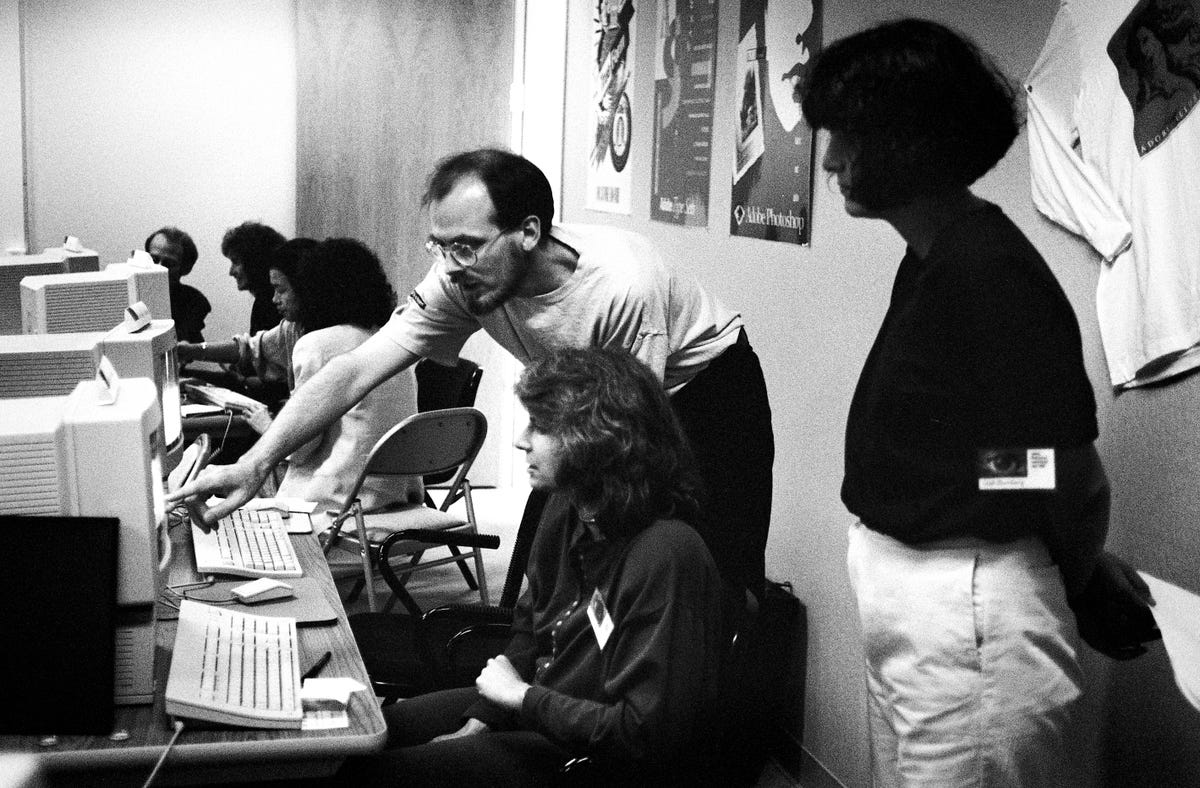Photoshop at 25 -- the early days (pictures)
From films and magazine covers to architecture and astrophotography, the impact of Photoshop is everywhere. Here are its more humble beginnings.

The start
In 1987, Thomas Knoll developed a pixel imaging showcase program he called Display.
Along with his brother, John Knoll, the two began adding features to the simple gray-scale program to process digital image files.
It was the dawn of digital image manipulation.
In September 1988, Adobe decided to buy the license to distribute the software.
Today, the iconic software known as Photoshop touches nearly every segment of the design world.
Photoshop turned 25 on Thursday.
Here, Russell Brown, who was then Adobe Systems' creative director, talks with people attending Adobe's 1990 Photoshop Invitational.
Thomas Knoll
Thomas Knoll, co-creator of Photoshop, officially became an Adobe employee and Adobe Fellow in 2012 after 24 years as a collaborative consultant for the company's digital imaging team.

'Jennifer in Paradise'
In 1988, John Knoll met with Adobe to pitch the Display software using this "Jennifer in Paradise" image -- a photo of John's future wife on the beach in Bora Bora.
At the meeting, he showed how he could easily manipulate the image by cloning both Jennifer and the island.
The demo won over Adobe.
Adobe back in 1989
Photoshop was launched on February 19, 1990 -- for Apple Macintosh computers only.
"Adobe thought we'd sell about 500 copies of Photoshop a month," said Thomas Knoll in a statement this week.
According Adobe, the application now has more than 10 million users worldwide.
Some of the first features included the Lasso Tool, Magic Wand, Eyedrop Tool, Smudge Tool, Stretch/Shrink and Hue/Saturation adjustments.
Russell Brown in 1989
An art director at Adobe in 1989, Russell Brown is now the senior creative director and an Emmy Award-winning instructor.
In a 25th anniversary blog post, Thomas Knoll says of the initial software: "Photoshop 1 was primarily aimed at the publishing markets and graphic artist markets. But inkjet printers enabled a real photography workflow to begin, because photographers could scan film in, manipulate it in Photoshop, and then print out the images with an inkjet printer. Then that really exploded when digital cameras came out, and it suddenly became very easy to get lots of images directly into Photoshop."
Adobe, 1989
“Before Adobe Photoshop I could imagine artwork I wanted to make, but I didn’t have the pen control or the technical skill needed to bring my dreams into reality. With Photoshop, I’m able to draw on an infinite range of sources and combine them to say exactly what I need to say," Steve Caplin, who has written several books on Photoshop, said as part of Adobe's anniversary hoopla.
Photoshop 2.0 for Mac, 1991
Photoshop 2.0 for Mac debuted in June 1991, and by then Apple had added color to the Macintosh interface with System 7.
'We could do anything'
Thomas Knoll's brother, John, was an engineer at Industrial Light & Magic doing analog image composition, but ILM had also begun doing some preliminary experiments in digital processing in the 1980s.
The company had a scanner that could scan in frames from a movie, digitally process them, and then write the images out to film again.
In an interview that appeared this week on the Adobe blog, Thomas Knoll recalls his brother's "aha" moment in the development of the imaging software: “'If we convert the movie footage into numbers, and we can convert the numbers back into movie footage, then once it’s in the numerical form we could do anything to it. We’d have complete power.'”
Adobe, 1991
A chalkboard includes design notes from a Photoshop development meeting in 1991.
Photoshop 2.0
Russell Brown, Adobe creative director, at right in March 1991.
Version 2.0 of Photoshop included the Path feature, allowing people to trim around an object and save that path for future use.
This second generation of Photoshop also included support for CMYK, which refers to the four inks in color printing: cyan, magenta, yellow and key (black).
This CYMK support led to more widespread industry adoption of Photoshop because manipulated images could now be reproduced and printed.
Artists
Adobe creative director Russell Brown (left, seated) chats with artists Nicholas Callaway (center, seated), British painter David Hockney (right, standing) and other colleagues at Adobe's Art Directors Invitational in 1990.
The creative power that Photoshop released for artists of all types continues to resonate today.

